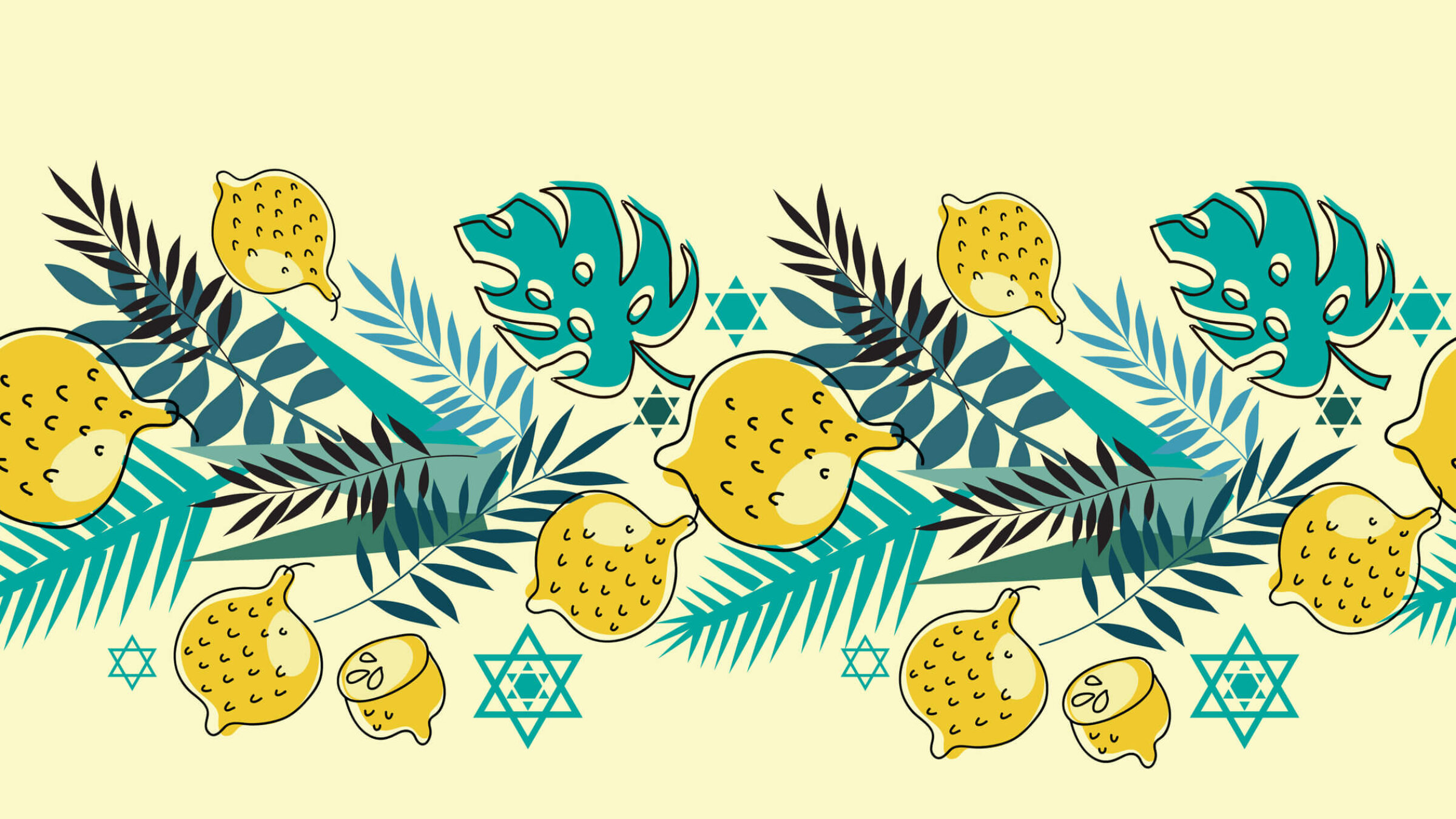Here’s what you need to know to celebrate Sukkot in 2023
A very Forward guide to the Jewish harvest festival of Sukkot

Jews celebrate Sukkot with the arba minim, a group of four plants bound together with straw: the lulav (palm frond), etrog (citron), hadassim (myrtle), and aravot (willow). The plants symbolize the various fruits of the earth but also the different kinds of people integral to a strong community. Photo by iStockPhoto
Celebrate Sukkot in 2023
Editor’s note: With the 2023 High Holidays upon us, we’re refreshing and republishing older stories about the holiday season for readers to enjoy with updated information. This story was originally published on Oct. 7, 2019.
After the honey-highs of Rosh Hashanah and the hunger pains of Yom Kippur, you might think it’s time to take a pause on Jewish holidays — but you’d be wrong. While it’s often overshadowed by the High Holidays, the week-long festival of Sukkot is one of the most enjoyable — and Instagrammable — of Jewish holy days. Wondering how to celebrate, or what to bring to a friend’s sukkah? Let us guide you through the “Feast of the Tabernacles.”
Wait, feast of the what? What is Sukkot, anyway? Why does it have so many names?
Sukkot is an ancient holiday celebrating the completion of each year’s successful harvest. Historically, Jews have used the holiday to thank God for the abundance of nature and pray for rain and healthy crops in the next year. For modern and secular Jews, it’s an opportunity to spend time with family and appreciate the beauty of the natural world. Sukkot derives its name from the sukkahs, or temporary outdoor structures, that people build in order to celebrate the holiday. It’s also sometimes called “Chag HaAsif,” or “Festival of the Ingathering,” a name that refers to the yearly harvest.
How Did Sukkot Start?
Harvest festivals are common across cultures, and scholars speculate that Sukkot existed in some form long before it was written down in the Torah — but as Judaic law evolved, it adapted pre-existing traditions to fit its own needs. In Leviticus, God tells Moses that Sukkot is both a celebration of the harvest and a commemoration of the years in which the Israelites lived in huts while wandering Egypt. So, the Torah adds historical significance to what was probably once an agricultural festival.
When is Sukkot and How Long Does It Last?
Sukkot lasts for seven days, and keeping them all straight can be harder than building a sukkah from scratch. Here’s a back-to-basics breakdown on the meaning of each part of the holiday. Like all Jewish holidays, Sukkot starts at sundown, so all dates in parentheses start in the evening and include the following calendar day.
- Sukkot begins five days after Yom Kippur (in 2023, Sept. 29 at sundown). The first two days are yom tov, or “holy days,” which means Shabbat restrictions apply. Religious Jews abstain from working or driving on these days.
- The next four days (in 2023, Oct. 1 at sundown to Oct. 4 at sundown) are known as chol hamoed, or “festival weekdays.” In Jewish tradition, they lie somewhere between regular days and full-on holidays. Shabbat restrictions don’t apply, but depending on their denomination synagogues may host special services. Jews are encouraged to spend time, enjoy meals, and (if we’re feeling intrepid) sleep in our sukkahs.
- The final day of Sukkot is Hoshana Rabbah, the “Great Supplication” (in 2023, Oct. 5 at sundown to Oct. 6 at sundown). Synagogues host special services to mark the end of the holiday and pray for the seven patriarchs of the Torah.
- Here’s where it gets tricky. The eighth day, Shemini Azeret (in 2023, Oct. 6 at sundown to Oct. 7 at sundown) is technically its own holiday, but its only purpose is to mark the end of Sukkot, so it’s effectively part of the festival. Shemini Azeret is a yom tov with Shabbat restrictions. Many Jews continue to use their sukkahs for meals and leisure time, but without saying the blessings associated with Sukkot.
- In Israel, the fun ends here. For lucky Diaspora Jews, the party continues with Simchat Torah (in 2023, Oct. 7 at sundown to Oct. 8 at sundown), also a yom tov. This holiday commemorates the importance of the Torah in Jewish life. Jewish communities celebrate the holy text through an evening of singing and dancing.
What about those huts you mentioned before?
Sukkot’s most recognizable symbol is the “sukkah,” a temporary hut which can be built in any available outdoor space. Sukkahs are a tribute both to the temporary structures built by ancient field laborers and the hardships the Israelistes endured as they wandered through the desert. Spending time in a sukkah invites Jews to remember the past, cultivate gratitude, and, according to Megan Whitman of Manhattan’s Marlene Meyerson JCC, “shake up our sense of what is temporary and what is permanent.”

A sukkah built on Ellis Island in 1948. Image by Getty
How do you build a sukkah?
There are a few ground rules for building a sukkah: it must have three walls, and it must be large enough to contain at least a table and one person. The roof, usually covered with branches or reeds, must provide both shade and a view of the sky outside. These guidelines ensure that the sukkah strikes a balance between providing shelter and letting in the natural world.
Within this general framework, sukkahs come in many shapes, sizes, and styles. Sukkot newbies can buy sukkah kits to assemble a basic structure of tarp and metal, while more ambitious minds design Pinterest-worthy woodland bowers. Suburban dwellers can festoon their sukkahs with materials from their own backyards; meanwhile, in urban Jewish neighborhoods tiny sukkahs spring up on apartment balconies, using every inch of available space.
Sukkahs can be communal affairs as well. With the help of their congregations, many synagogues and Jewish organizations construct sukkahs which encourage visitors to consider different themes of the holiday. In 2019, the JCC Harlem built two sukkahs in conjunction with Chabad and Art in Flux, a Harlem-based arts collective. Art in Flux connected the JCC with local artist Elan Cadiz, who designed that year’s sukkah in accordance with the theme “Who Will You Invite In?” Constructed from founded objects and fabrics donated by the community, the sukkah explored what it means to be “strange” or “indigenous” in the historic neighborhood, said JCC Harlem director Meg Sullivan.
Farther south in Manhattan, the Marlene Meyerson JCC commissioned two Iraeli artists, Dede Bandaid and Nitzan Mintz, to build a sukkah called “Shelter.” The sukkah featured a motif of wooden birds in flight, to evoke “the troubled migrations of so many children and adults in today’s world.” The artists used discarded materials from the neighborhood to build the sukkah, rooting the structure in Manhattan even as it considered global dilemmas.
Sukkahs have even formed the basis art exhibitions. In 2010, the architecture competition “Sukkah City” solicited designs from international artists and constructed twelve highly conceptual sukkahs in Union Square.

The JCC Harlem’s 2018 sukkah. The holiday’s theme was “Who’s a stranger?” Image by courtesy of JCC Harlem
What exactly goes on in a Sukkah?
Pretty much anything! The Torah commands Jews to eat in their sukkahs, and the more intrepid among us may even spend the night there. More broadly, the sukkah is a good place for any activities that inspire gratitude and build connections with those around us.
JCC Harlem director Meg Sullivan is looking forward to hosting her second annual “evening of radical welcome,” in which community organizations from the Sephardic Mizrahi Q Network to Repair the World Harlem and Kehillat Harlem will gather in the sukkah to celebrate the holiday and discuss local concerns, like anti-bias work. Last year, she recalls, a local musician happened upon the event with his saxophone, making for a night of spontaneous music.
Meanwhile, at Manhattan’s Congregation Rodeph Sholom, religious school students and families will gather in the synagogue’s courtyard sukkah to assemble “dignity kits” for the West Side Campaign Against Hunger.
While some sukkahs pose philosophical questions or encourage community service, others are much more utilitarian. Jewish chef Amy Kritzer even recalls a supermarket in her Texas neighborhood that built a sukkah so that customers at the kosher deli could grab a quick lunch while fulfilling the rituals of Sukkot.

Balconies in an ultra-Orthodox Jerusalem neighborhood sport small wooden sukkahs. Image by Getty
How else do people celebrate Sukkot?
Besides building a sukkah, Jews celebrate Sukkot with the arba minim, a group of four plants bound together with straw: the lulav (palm frond), etrog (citron), hadassim (myrtle), and aravot (willow). The plants symbolize the various fruits of the earth but also the different kinds of people integral to a strong community. Each day of Sukkot, congregants circle the synagogue while holding the arba minim and saying prayers (on Hoshana Rabah this is done seven times). At home, families may say a prayer inside the sukkah while holding arba minim, and then shake the branches in each direction to bless the space.

The etrog, or citron, is a key part of the arba minim, four plants which symbolize the bounty of the harvest and are used in Sukkot blessings. Image by Tori Avey
What do people eat during Sukkot?
This is, of course, the most important question of all — but for better or worse, there’s no straight answer. While menus for other Jewish holidays have remained the same for generations, there is no “typical” Sukkot feast. The only definitively traditional Sukkot dish is kreplach (dumplings stuffed with meat and potatoes).
Food historian Tori Avey explains that stuffed foods like kreplach “symbolize the bounty of the harvest” and serve to remind Jews that we are “wrapped in blessings.” While kreplach is an Ashkenazi dish, Avey incorporates the traditions of her husband’s Sephardic family by serving lots of vegetable mezze, such as cooked eggplant salad.
Jewish food blogger Amy Kritzer builds on this tradition by filling her Sukkot table with stuffed vegetables, like eggplants and peppers. She also serves foods associated with Rosh Hashanah, like leeks and pomegranate, in order to continue the celebration of the Jewish New Year, and autumnal vegetables like pumpkins and gourds that evoke American Thanksgiving.

A family sukkah decorated with leaves and branches. Image by Tori Avey
So basically, this is a week-long extravaganza of eating delicious things and lounging outside?
Exactly! (And not exactly.) Sukkot is a great excuse to share a meal with friends or learn to stuff eggplants. More broadly, the holiday celebrates values that are universal to Jews and non-Jews alike, like gratitude and generosity. It’s an invitation to break the routines that normally govern daily life. No matter how many walls your sukkah has or what you serve inside it, if you make time to appreciate things you take for granted — from friends and family to the beauty of the natural world — you’ve participated in the spirit of Sukkot.
Correction: An earlier version of this republished article misstated the dates of the JCC Harlem’s and the Marlene Meyerson JCC’s sukkahs used as examples. They were built in 2019, not 2023.
























